Configure Windows XP SP2 network protection technologies on a computer
A computer connected to the Internet may appear vulnerable to an attack. The attack here is an intentional crossing of the computer's security layer or taking away the right to use the computer.
In Microsoft Windows XP Service Pack 2 (SP2), Microsoft offers a number of new technologies that help help protect computers. These technologies do not replace periodic security updates. They help strengthen the overall defense of Windows XP with malicious code attacks. Windows Security Center is the point to start related items and web links related to security. Windows firewall is integrated in Windows XP SP2 and protects the computer by blocking unsolicited connections. Programs on computers like Internet Explorer or Outlook Express still work because the Windows firewall still allows on-demand connections from the computer.
The default settings from Windows XP SP2 help you protect your computer. If the default settings do not have the necessary security requirements, you can use the instructions in this document to configure a safer setting. These settings allow efficient computer use while still reducing the risk of malicious code attacks.
To configure network protection technologies, you must perform the following tasks:
-
Use Windows Security Center to configure Automatic Updates, Windows Firewall settings and identify virus protection states.
-
Configure Microsoft Internet Explorer
-
Configure Microsoft Outlook Express
-
Wireless Networking Security configuration
Important : The instructions in this document have been developed with the Start menu appearing by default when installing the operating system. If you have changed the Start menu, the steps may differ slightly.
Before start
This document will help you set up network protection features of Windows XP Professional SP2 and Windows XP Home Edition SP2 on a single computer.
Use Windows Security Center
Security Center service acts as a background process and checks the necessary security status on the user's computer:
-
Firewall . Security Center checks whether Windows Firewall is turned on or off. Security Center can also check for the presence of some third-party firewalls.
-
Automatic Updates . Security Center checks to make sure Automatic Updates is set up in the preferred settings, it automatically downloads and installs necessary updates. If Automatic Updates is set to shut down or does not set priority settings, the Security Center will make appropriate recommendations.
-
Virus Protection. Security Center checks the presence of virus software by using queries for specific Windows Management Instrumentation (WMI) vendors, and many tools created by other vendors. If the information is valid, the Security Center will report whether the software is up to date and whether real-time scanning is enabled.
If a security element is found in conditions that are not secure enough or cannot be detected, the Security Center displays the red shield in the taskbar's attention area and will show a warning message when logging in. This message links to the Security Center to display a problem message and provides tips to help you overcome this situation.
If you use an antivirus program or firewall that you test yourself, you can change the way Security Center protects the program.
Procedures for using Security Center are:
-
Change Security Center Alerts
-
Configure Windows Firewall
-
Automatic Updates configuration
Required to perform this task
You must be logged in as an internal admin security group member
Change Security Center Alerts
You cannot use antivirus software and firewalls in the same direction as the Security Center. If using a software that is not able to detect, you must configure the Security Center options to allow it to check the security status and you will not receive prompt messages to change the configuration.
To change the Security Center alerts
first.Click Start , and then click Control Panel .
2.On the window select Pick a category , click SecurityCenter .
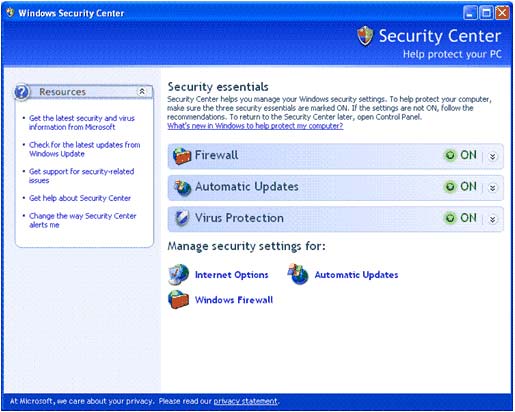
Figure 1: SecurityCenter Security Center
Under Resources, click Change the way SecurityCenter alerts me .
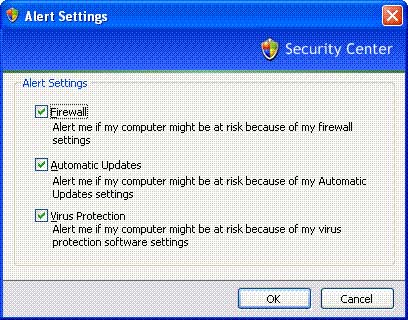
Figure 2: Alert settings
Delete alert settings to meet your requirements
5. Click OKWindows Firewall
The default settings for Windows Firewall are necessary for most users. The default and meaningful settings when possible are given in Table 1.
Table 1 : Default settings of the firewall
Option
Default configuration
Detailed description
Mạng kết nối đặt
All connections
You do not require Windows Firewall protection for a specific connection, or require settings on a connection.
Program exceptions
Remote Assistance only
You need to connect from other programs or services to your computer.
Port exceptions
None
You need to connect from other computer programs that use a specific port on the computer.
ICMP exceptions
None
You need other computers to verify that your computer exists and that TCP / IP is configured correctly.
Notifications
On
You don't want to be notified when other computers fail to connect to your computer.
Logging
Off
You need a log to record connections or try to make connections to your computer
Don't Allow Exceptions
Off
You are quite clear about the security holes on your computer, the vulnerabilities have not yet applied patches.After you have updated the patch, reset this setting to Off.
Note : Although this document explains how to change the default settings, if done, you may be inadvertently increasing the vulnerability of your computer to attacks. If you add any of the exception options listed in Table 1, for each option you can define a range of activities. The scope of operations is an optional configuration that allows you to specify which computers can use the exception program on your computer. If you configure the scope for the local network, the computers on the same subnet can connect to the program on the computer. However, traffic from a remote computer is not allowed.
To configure the default settings, Windows Firewall performs the following procedures on your computer.
-
Enable Windows Firewall on a network connection
-
Configure the exception program
-
Configure exception ports
-
ICMP configuration exception
-
Disable notifications
-
Install firewall log settings
-
Use exceptions without permission.
Important : If you change any of the above settings except Don't allow exceptions, it may also increase the vulnerability in your computer to attacks.
To enable Windows Firewall on a network connection
first.From SecurityCenter , under Manage security settings for you click Windows Firewall .
2.In Windows Firewall , click the Advanced tab .
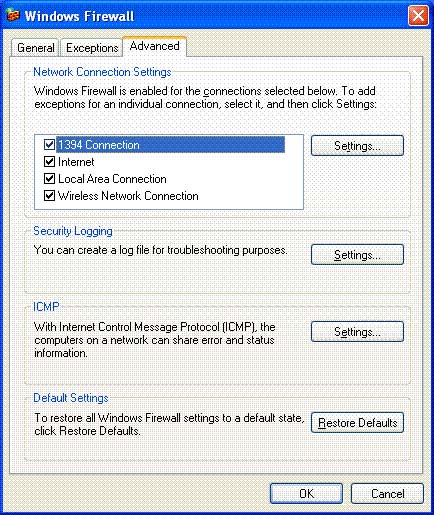
Figure 3: Advanced firewall settings
On the Advanced tab, in the Network Connection Settings area , delete all connections that you do not need to protect the firewall.
Note : Windows Firewall is enabled for all connections. If you used a third-party firewall product (a locally installed firewall) on a private connection, you should disable Windows Firewall only for that connection.
4.On the Advanced tab, in the Network Connection Settings area , click the specific connection to configure the settings other than the default, then click Settings .
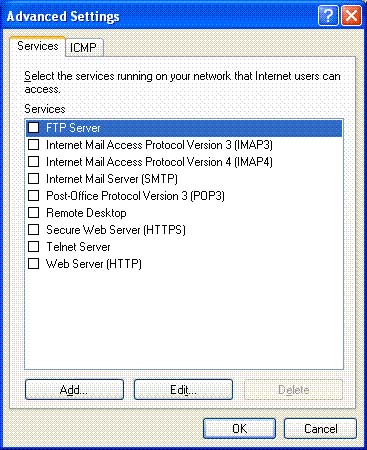
Figure 4: Advanced settings of Windows Firewall on connection
Select or delete the specific service you want to enable or disable this connection.
6.If the service you want to enable for this connection is not displayed, click Add .
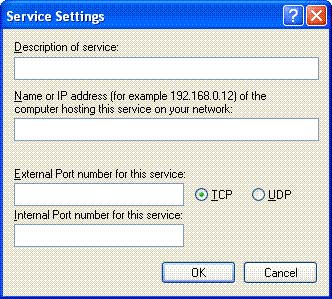
Figure 5: Service settings for a specific network connection.
On the Service Settings window, enter details for the service you want to activate and then click OK .
8.Click OK to close the Advanced Settings window
Configure the exception program
first.In Windows Firewall click the exception tab ( Exceptions)
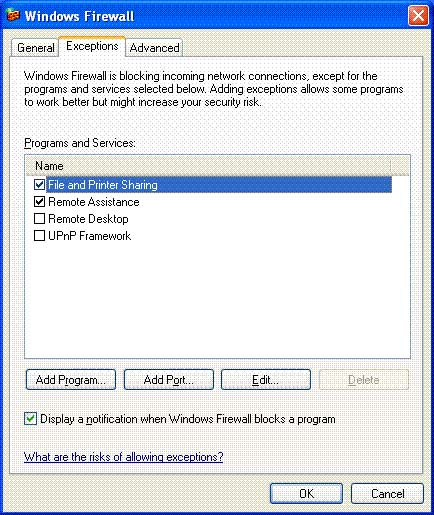
Figure 6: Exceptions of Windows Firewall
3.
If the program or service is not listed and you want to activate the program to create a connection through Windows Firewall, click Add Program .
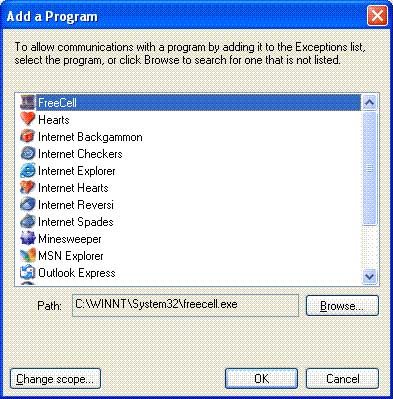
Figure 7: Adding more programs
In the Programs list , click the program you need through Windows Firewall
Note : If the program is not listed, click Browse and browse to the program. Click the program and then click Open .
5.Click Change scope .
Note : Changing the scope is an optional configuration that allows you to specify which computers can use the desired program on the computer. If you do not need to define a scope, you can skip step 8.
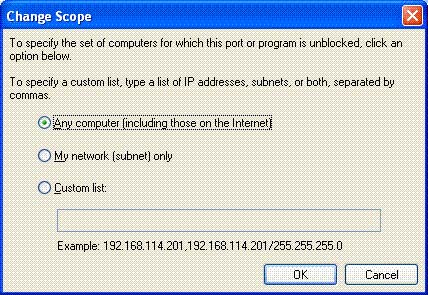
Figure 8: Change scope
Click:
-
Any computer (including those on the Internet) , to allow unsolicited access to your program
-
My network (subnet) only , to allow computers on the same subnet with your computer to access the program
-
Custom list , to allow only the computers you specify in the custom list field to access the program.
Click OK.
In the Add a Program box, click OK .
9.Click OK.
To configure the exception port
first.In Windows Firewall , click the Exceptions tab
In the Programs and Services area , click Add Port .
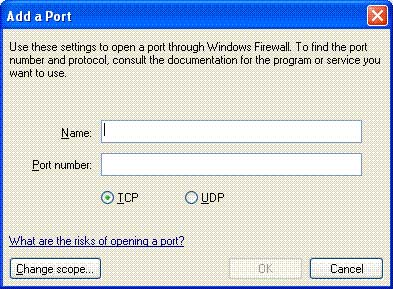
Figure 9: Add port
In the Name field, type the name of the port you want to add. In the Port number field, type the appropriate port number. Click the appropriate TCP or UDP button
4.Click Change scope.
Note : Changing the scope is an optional configuration that allows you to specify which computers can use the desired port on your computer. If you do not need to define the scope, you can skip step 7.
5.Click
-
Any computer (including those on the Internet) , to allow unsolicited access to your computer through the port
-
My network (subnet) only , to allow computers on the same subnet to access your computer through the port
-
Custom list , to allow only the computers you specify in the list option field, can access your computer through the port.
Click OK .
7.In the Add a Port box, make sure your new port is added to the Programs and Services list and then click OK .
8.In the Add a Port box , click OK
Configure ICMP exceptions
first.In Windows Firewall on the Advanced tab, in the ICMP section, click Settings .
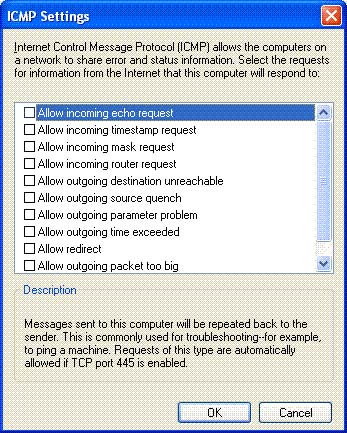
Figure 10: ICMP settings
Select the appropriate setting for ICMP exceptions, for example, if you want to activate your computer to respond to the 'ping' command, select Allow incoming echo request , then click OK .
Note : This is the default setting if the File and Printer Sharing exception is enabled
Disable notifications
In Windows Firewall , on the Exceptions tab, delete Display a notification when Windows Firewall blocks a program , then click OK .
To install Windows Firewall log settings
first.In Windows Firewall , on the Advanced tab, in the Security Logging section, click Settings .
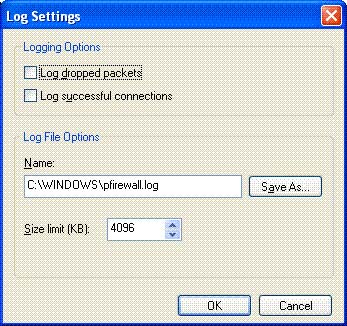
Figure 11: Record settings
On the Log Settings window, select Log dropped packets to record all connection attempts removed by the firewall and Log successful connections to record all connection attempts allowed by the firewall.
3.Enter a path and name for your record (pfirewall.log is the default file)
Note : The location for your log file must be guaranteed to prevent accidental or deliberate changes to the log.
4.Configure the size limit to ensure that your record does not increase to an unmanageable size, then click OK .
5.Click OK to close Windows Firewall and apply the settings
Use the ' Don't allow exceptions ' option
Note : Use this setting when you need maximum protection for your computer such as when connecting to a public network in a hotel or an airport, or when a new vulnerability is discovered and you don't have time To update the patch or no patch is provided.
first.In SecurityCenter , under Manage security settings for , click Windows Firewall .
2.On the General tab, select Don't allow exceptions .
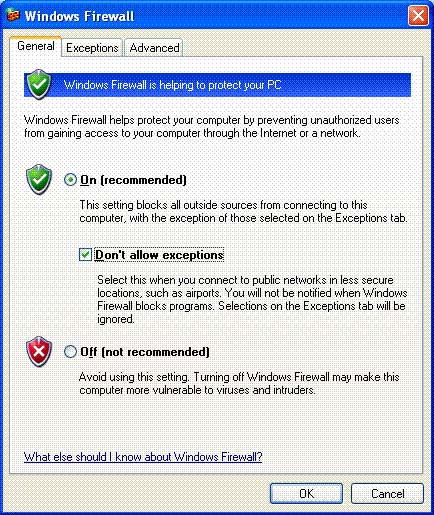
Figure 12: Exceptions for Windows Firewall are not allowed
Click OK then close SecurityCenter .
Automatic Updates configuration
The default settings for Automatic Updates are necessary for most users. In this case, Windows periodically checks the Windows Update website to update updates promptly to help protect your computer when encountering the latest vulnerabilities and other threats. These updates may include security upgrades and service packs. Depending on the settings you choose, Windows will automatically download and install when there are updates that your computer needs, or notify you of new updates.
Note : Automatic Updates will only automatically load system updates with high priority. Use Office Update to upgrade to Microsoft Office.
To configure Automatic Updates
first.Open SecurityCenter , then under Manage security settings for , click Automatic Updates .
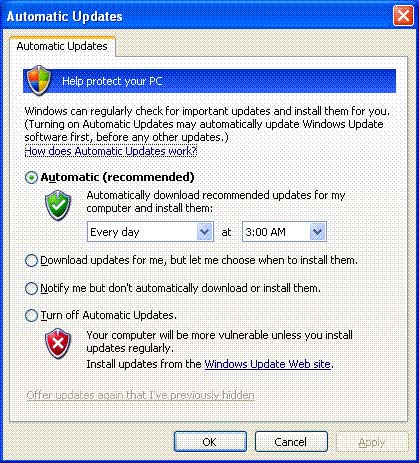
Figure 13: Automatic Updates
Click on one of the options that matches your desired configuration, then click OK .
-
Automatic (recommended) , then enter the download schedule
-
Download updates for me, but let me choose when to install more (Download updates but allow to choose when installing them)
-
Notify me but don't automatically download or install thêm . (Notify you but don't automatically download or install them)
-
Turn off Automatic Updates . (Turn off Automatic Updates )
Verify the settings of the applicable security center
Verify the security center's warnings are applied
To verify the SecurityCenter warnings are applied
first.From the Windows XP SP2 desktop, click Start , click Control Panel .
2.Under Pick a category , click SecurityCenter .
3.Under Resources , click Change the way SecurityCenter alerts me .
4.Verify that the desired alert configuration is applied to your computer and then click OK to close Alert Settings.
Verify the firewall settings are applied
To verify the Windows Firewall settings are applied
first.From SecurityCenter , under Manage security settings for , click Windows Firewall .
2.Click the General , Exceptions , and Advanced tabs, verify the desired configuration is applied to Windows Firewall on your computer and then click OK to close Windows Firewall.
Verify the Automatic Updates settings are applied
To verify the Automatic Updates settings are applied
first.From the Security Center , under Manage security settings for , click Automatic Updates .
2.Verify the desired configuration is applied to Automatic Updates on your computer and then click OK to close Automatic Updates.
 Part II: Configuring Internet Explorer
Part II: Configuring Internet Explorer
 Part III: Configuring Outlook Express
Part III: Configuring Outlook Express
 Part IV: Configuring Wireless Network Security
Part IV: Configuring Wireless Network Security
You should read it
- How to turn on / off Windows Firewall in Windows 7, 8 / 8.1 and Windows 10
- How to set up a firewall in Linux
- How to Turn On Windows Firewall
- 3 ways to turn off the Windows 11 firewall, steps to turn off the firewall on windows 11
- How to Customize Windows Firewall with Windows Firewall Control
- 3 ways to turn off the Windows 10 firewall, steps to turn off the firewall on Windows 10
- How to turn firewall (Firewall) on Win 7
- Instructions allow applications to communicate with each other via Windows Firewall
May be interested
- Instructions for configuring IPv6 on Windows Server
 assigning addresses on an ipv6 network is a bit different from ipv4. ipv6 can be assigned to an interface in four ways in how to configure this ipv6.
assigning addresses on an ipv6 network is a bit different from ipv4. ipv6 can be assigned to an interface in four ways in how to configure this ipv6. - How to open Windows Security in Windows 10
 as we know, windows 10 provides users with the latest anti-virus protection with windows security.
as we know, windows 10 provides users with the latest anti-virus protection with windows security. - How to Configure Computers on a Local Network
 in this article, tipsmake will guide you how to install a lan (local area network) to connect multiple windows computers.
in this article, tipsmake will guide you how to install a lan (local area network) to connect multiple windows computers. - 9 tips to protect your computer safely from virus attacks
 if you are using windows 7, 8 and windows 10 operating systems, you should enable windows update. microsoft regularly releases new patches and security updates for windows operating systems.
if you are using windows 7, 8 and windows 10 operating systems, you should enable windows update. microsoft regularly releases new patches and security updates for windows operating systems. - How to change the network configuration name in Windows
 the first time you configure and connect to the network, windows stores that information as a network configuration and names it the most generic name such as network, network 1, etc. if there are multiple networks, names the default may cause confusion for users. this article will show you how to change the network configuration name.
the first time you configure and connect to the network, windows stores that information as a network configuration and names it the most generic name such as network, network 1, etc. if there are multiple networks, names the default may cause confusion for users. this article will show you how to change the network configuration name. - Ten free ways to keep your computer safe
 you do not have to use the risk to protect your computer from viruses, trojans, phishers, scammer or snoop. and in fact, you don't have to lose a penny.
you do not have to use the risk to protect your computer from viruses, trojans, phishers, scammer or snoop. and in fact, you don't have to lose a penny. - How to fix 'Mmc.exe blocked for your protection' error on Windows 10
 you may get 'mmc.exe blocked for your protection' error on windows 10 when trying to run computer management. however, this is not a huge problem and can be handled with just a few adjustments to the settings.
you may get 'mmc.exe blocked for your protection' error on windows 10 when trying to run computer management. however, this is not a huge problem and can be handled with just a few adjustments to the settings. - Steps to fix 'This app has been blocked for your protection' error
 during the software installation process, you often receive the message 'this app has been blocked for your protection' on your windows 10 computer but don't know how to fix it.
during the software installation process, you often receive the message 'this app has been blocked for your protection' on your windows 10 computer but don't know how to fix it. - How to turn on Tamper Protection for Windows Security on Windows 10
 tamper protection is a new feature of windows 10 may 2019 update. tamper protection is disabled by default, follow the instructions below to enable it.
tamper protection is a new feature of windows 10 may 2019 update. tamper protection is disabled by default, follow the instructions below to enable it. - How to set up and configure DDNS on Netgear router
 this guide will help you set up and configure dynamic dns (ddns) on netgear router. using the dynamic dns built into the router means you don't have to keep the computer running all the time on the network to access the remote network.
this guide will help you set up and configure dynamic dns (ddns) on netgear router. using the dynamic dns built into the router means you don't have to keep the computer running all the time on the network to access the remote network.










 Resisting against DoS attacks
Resisting against DoS attacks Home computer at any potential risk
Home computer at any potential risk Solve the threat from the network
Solve the threat from the network Class-based defense solution for VoIP networks
Class-based defense solution for VoIP networks Protect personal information on 'social networks'
Protect personal information on 'social networks' Five tips for safe online shopping
Five tips for safe online shopping